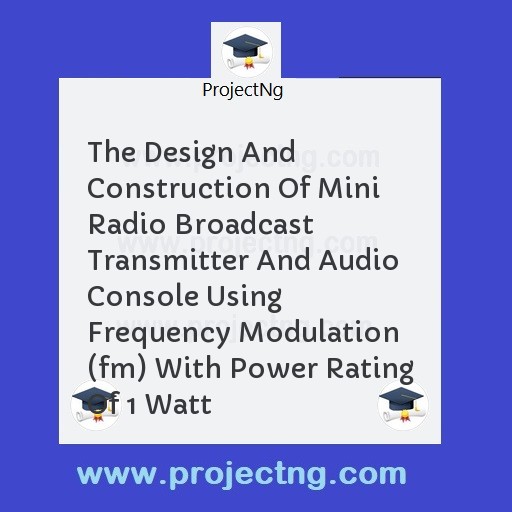The Design And Construction Of Mini Radio Broadcast Transmitter And Audio Console Using Frequency Modulation (fm) With Power Rating Of 1 Watt
Electrical/electronic Engineering Project Topics
Get the Complete Project Materials Now! »
THE DESIGN AND CONSTRUCTION OF
MINI RADIO BROADCAST TRANSMITTER
AND AUDIO CONSOLE USING FREQUENCY
MODULATION (FM) WITH POWER
RATING OF 1 WATT
ABSTRACT
The early transmitter for radio broadcasting is so big and bulky that they do occupy numerous spaces. The circuitries are mainly designed with valves, which are big in sizes.
With the advent of semiconductor materials such as transistors electronic equipment are now becoming miniaturized such that small transmitters are now becoming handy and compact.
In line with this we choose to design a complete radio broadcasting equipment tat is compact and existence of semiconductor materials.
The system units are of two categories namely: audio console for the processing and mixing of musicals is basically a condenser microphone.
The transmitter unit is where the center frequency is provided. All these were designed to be in compact and small manner. This project is aimed at serving a community using a small and compact radio broadcasting equipment with a power watt of 1 watt a community of 1 kilometer in radius should be covered comfortable and the audio production very clear unlike the common noisy FM microphone project.
TABLE OF CONTENT
Title page
Approval page
Declaration
Dedication
Acknowledgement
Abstract
Table of content
List of diagram/figures
Introduction
CHAPTER 1 TRANSMITTER FUNDAMENTALS
AND TYPES OF MODULATION
1.1 Transmitters fundamental
1.2 Modulations (analog and digital)
1.3 Amplitude modulation
1.4 Frequency modulation
1.5 Method of fm
1.6 Modulation overview
1.61 Basic reactance modulator
1.62 Theory of reactance modulator
1.70 Types of reactance modulator
1.7.1 Varacto diode modulator
CHAPTER 2 AMPLIFIER EXPLANATIONS
2.10 Amplifier explanations
2.20 Class of amplifier
2.21 Class of amplifier
2.22 Class B amplifier
2.23 Class AB amplifier
2.24 Class c amplifier
2.30 Oscillators
2.31 Types of oscillators
CHAPTER 3.0
TRANSMISSION LINE
3.10 FUNDAMENTALS
3.30 Types of transmission lines
3.31 Rectangular wave guide
3.32 Circular wave guide
3.33 Ridge Wave guide
3.34 Optical fiber
CHAPTER 4
POWER SUPPLY
4.1 Stages of power supply
4.2 Audio console power supply
4.3 Transmitter power supply design
CHAPTER 5 AUDIO CONSOLE UNIT
5.1 Audio console transducer
5.2 Audio console pre-amp stage
5.3 Audio console power amp stage
5.4 Audio console control/mixer
5.5 The operation of the audio console
CHAPTER 6 TRANSMITTER AND ANTENNA DESIGN
6.1 Oscillator stage design for transmitter
6.2 Buffer/power amplifier design
6.3 Tank circuit design
6.4 Antenna design
6.41 Types of antenna and application
6.42 Antenna matching network
6.43 Antenna design
CHAPTER 7 COMPONENT DESCRIPTION AND CONSTRUCTION
7.10 LM 386-power amplifier
7.11 Capacitor
7.12 Transistor
7.2 Specification
7.3 Construction and soldering
7.4 Precautions taken during soldering
7.5 Troubleshooting
7.6 Transmitter strip board
7.7 Audio console strip board
RECOMMENDATION
CONCLUSION
REFERENCE:
LIST OF FIGURES AND DIAGRAM
Fig 1.4 Information signal
Fig 1.62 Reactance modulator circuit
Fig 1.7 Reactance modulator elements
Fig 1.7 Diagram of transistor reactance modulator
Fig 1.8 Varactor diode modulator
Fig 2.1 Amplifier configuration
Fig 2.21 Class a wave form representation
Fig 2.22 Voltage current characteristic of class b amp
Fig 2.3 Block diagram of an oscillator
Fig 3.2 Balanced line
Fig 3.22 Unbalanced wire – line
Fig 3.3 Method of wave propagation in a waveguide
Fig 3.31 Te10 mode in a rectangular waveguide
Fig 3.32 Circular waveguide
Fig 3.33 Rectangular waveguide/ ridge
Fig 3.4 Optical fiber cable
Fig 4.1 Power supply block diagram
Fig 4.2 Audio console power supply regulator
Fig 4.3 Transmitter power supply
Fig 5.2 Audio console pre-amp
Fig 5.3 Audio console power amp
Fig 5.4 Audio console control/ mixer
Fig 6.1 Oscillator stage
Fig 6.2 Buffer amp/power amp
Fig 6.3 Tank circuit
Fig 6.42 Antenna matching network
Fig 7.1 LM 386 (power amp)
Fig 7.11 Capacitor
Fig 7.12 Transistor
Bill of quantity
Block diagram of audio console
Block diagram of transmitter
Audio console schematic
Transmitter schematic
Transmitter casing
Audio console casing
INTRODUCTION
This our project work is all about design and construction of a complete radio broadcasting equipment that is compact and miniaturized. It is capable of delivering a power output of 1 watt and assumed to cover a distance of 400 meters ie 200 meters radius depending on obstructions.
The transmitted signal is frequency modulated stays constant and its frequency varies according to the amplitude variations of the audio signal. When the input signals amplitude increases (ie during the positive half cycle) the frequency of the carrier increases too, on the other hand when the input signal decreases in amplitude (negative half-cycle or no signal) the carrier frequency decreases accordingly.
The output frequency of the transmitter is adjustable from 88 to 108 MHZ, which is the FM band that is used for radio broadcasting. The circuit as we have already mentioned consist of four stages. Three RF stages and one audio preamplifier for the modulation. The first RF stage is an oscillator is
Be the First to Share On Social

Enjoying our content?
Don't miss out on new videos! Subscribe to our YouTube channel for more awesome content.
Subscribe Now!













